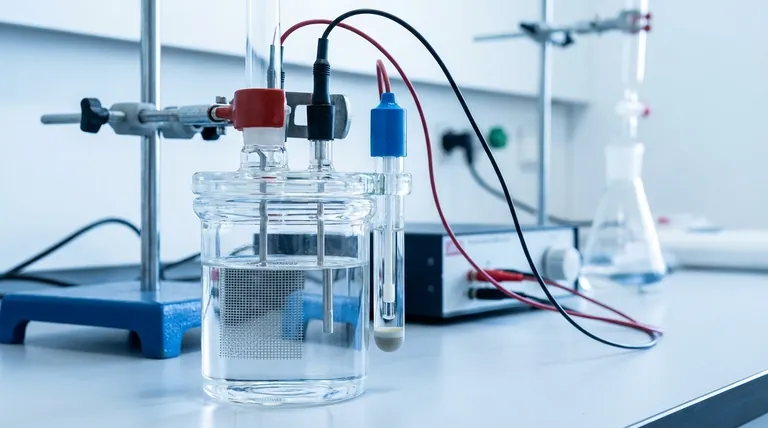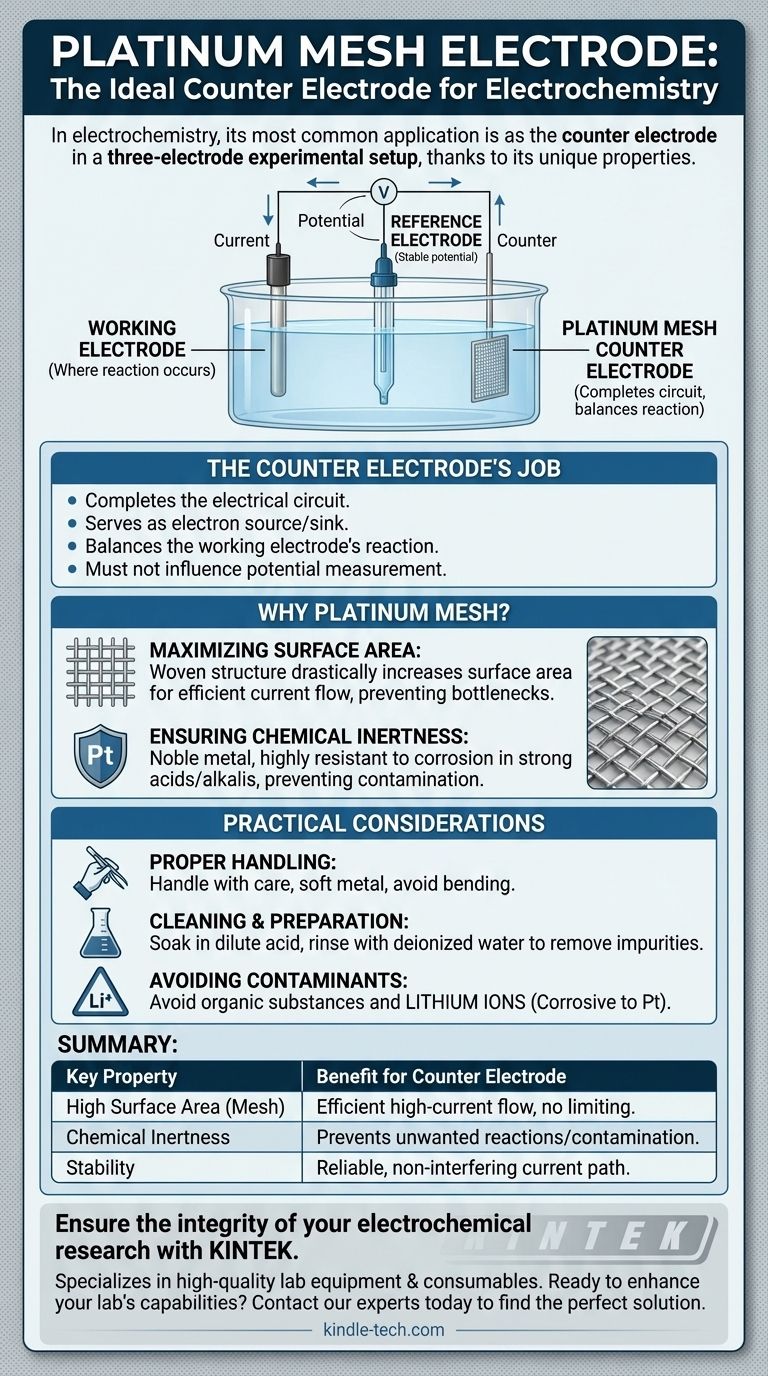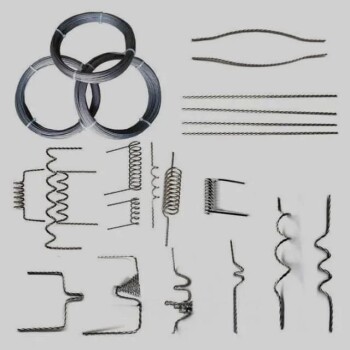In electrochemistry, the most common application for a platinum mesh electrode is to serve as the counter electrode in a three-electrode experimental setup. Its unique properties make it exceptionally well-suited for this role, where it completes the electrical circuit and supports the primary reaction without interfering with the measurement.
A platinum mesh electrode is the ideal choice for a counter electrode because its high surface area and chemical inertness allow it to efficiently pass current, completing the cell's circuit without introducing unwanted side reactions or limiting the experiment's accuracy.

The Role of the Counter Electrode
What is a Three-Electrode System?
In many electrochemical analyses, a three-electrode system is used to precisely study a reaction. This setup isolates the different functions required for the experiment.
The working electrode is where the chemical reaction of interest occurs.
The reference electrode provides a stable, constant potential against which the working electrode's potential is measured. It does not pass significant current.
The Job of the Counter Electrode
The counter electrode, also known as the auxiliary electrode, has one primary job: to complete the electrical circuit.
It serves as the source or sink for the electrons driven through the working electrode, allowing current to flow. Its function is to balance the reaction happening at the working electrode without influencing the potential measurement.
Why Platinum Mesh is an Ideal Choice
Maximizing Surface Area
A key feature of the platinum mesh is its woven structure. This design dramatically increases the available surface area compared to a simple wire or plate of the same size.
This large surface area allows the counter electrode to pass current easily and efficiently, even at high rates. This ensures the counter electrode's performance does not become a bottleneck that limits the overall experiment.
Ensuring Chemical Inertness
Platinum is a noble metal, renowned for its exceptional stability and resistance to corrosion.
It remains stable in strong acids, strong alkalis, and high-temperature environments. This chemical inertness is critical, as it prevents the counter electrode from reacting with the electrolyte or producing byproducts that could contaminate the experiment and interfere with the reaction at the working electrode.
Understanding the Practical Considerations
Proper Handling is Crucial
Platinum is a soft metal. The mesh is therefore susceptible to physical damage if not handled with care.
You must avoid dropping, bending, or applying pressure to the mesh, as deformation can alter its performance characteristics.
Cleaning and Preparation
To ensure accurate results, the electrode surface must be clean. Before use, it is standard practice to soak the platinum mesh in a dilute acid, such as nitric acid, and then rinse it thoroughly with deionized water.
This process removes surface impurities or oxides that could impede its function.
Avoiding Specific Contaminants
You must prevent the electrode from coming into contact with organic substances or other materials that can "foul" or contaminate its surface.
Crucially, avoid any contact with lithium ions. Lithium is corrosive to platinum and its use with platinum electrodes is strictly prohibited, as it will cause irreversible damage.
Making the Right Choice for Your Experiment
Choosing a platinum mesh counter electrode is a decision rooted in the need for accuracy and stability.
- If your primary focus is accurate voltammetric analysis: The platinum mesh provides a stable, non-interfering path for current, ensuring your measurements at the working electrode are precise.
- If your primary focus is working in harsh chemical environments: The exceptional corrosion resistance of platinum allows for reliable performance in strong acids or bases where lesser materials would fail.
- If your primary focus is running high-current experiments: The high surface area of the mesh structure facilitates efficient current flow without polarization, preventing the counter electrode from limiting your reaction rate.
Ultimately, the platinum mesh electrode is a foundational tool for ensuring the integrity and reliability of electrochemical research.
Summary Table:
| Key Property | Benefit for Counter Electrode |
|---|---|
| High Surface Area (Mesh) | Enables efficient high-current flow without limiting the experiment. |
| Chemical Inertness | Prevents unwanted reactions and contamination in strong acids/bases. |
| Stability | Provides a reliable, non-interfering path for current in voltammetry. |
Ensure the integrity of your electrochemical research with the right lab equipment.
KINTEK specializes in high-quality lab equipment and consumables, including reliable electrodes for all your experimental needs. Our products are designed to deliver the accuracy and stability your work demands.
Ready to enhance your lab's capabilities? Contact our experts today to find the perfect solution for your laboratory.
Visual Guide

Related Products
- Platinum Sheet Electrode for Laboratory and Industrial Applications
- Rotating Platinum Disk Electrode for Electrochemical Applications
- Gold Disc Electrode
- Platinum Auxiliary Electrode for Laboratory Use
- RRDE rotating disk (ring disk) electrode / compatible with PINE, Japanese ALS, Swiss Metrohm glassy carbon platinum
People Also Ask
- What are the specifications of the Platinum-Titanium Functional Electrode? Maximize Electrochemical Performance
- What is the most critical guideline for immersing a platinum sheet electrode in an electrolyte? Ensure Accurate Electrochemical Measurements
- How should a platinum sheet electrode be operated during an experiment? Ensure Accurate and Reproducible Results
- What is the expected lifespan of a platinum sheet electrode? Maximize Your Electrode's Service Life
- How should a platinum sheet electrode be pretreated before use? Ensure Accurate Electrochemical Measurements



















